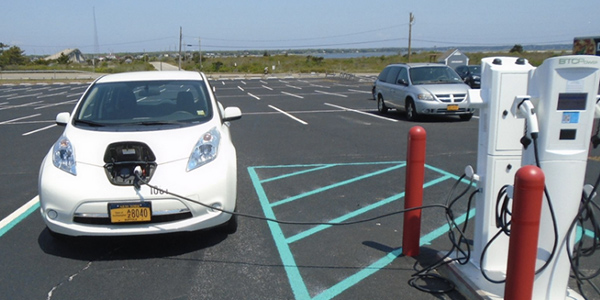The New York Public Service Commission on Thursday ruled that projects located anywhere in New York may be eligible for state-sponsored electric vehicle prize competitions, granting a request from the Long Island Power Authority (LIPA), which is normally not subject to PSC jurisdiction.
The commission in July approved just over $700 million in spending over the next five years to install more than 50,000 light-duty EV charging stations throughout the state, including $80 million for three prize competitions to be administered by the New York State Energy Research and Development Authority (NYSERDA) (18-E-0138). (See NYPSC Approves $700 Million for EV Chargers.)
The EV Make-Ready Program is funded by investor-owned utilities through a cost-sharing program meant to incentivize utilities and charging station developers to site EV charging infrastructure in places that will provide maximum benefits to consumers.
The commission’s declaratory ruling Thursday “remains consistent with the July order by continuing the policy that benefits will accrue to the ratepayers funding a chosen prize,” said Bridget Woebbe, assistant counsel in the Department of Public Service. “However, other communities throughout the state would also be allowed to participate in the prize competitions so long as a separate funding source is secured for any project selected outside of an investor-owned utility service territory.”
LIPA and its service provider, PSEG Long Island, have pledged to add 4,650 new charging ports by 2025 — enough to support 188,00 EVs — beginning with a proposed investment next year of $4.4 million.
Gov. Andrew Cuomo’s office said the three prizes are intended to support clean transportation options benefiting “lower socio-economic and environmental justice communities.”
They include a $40 million environmental justice program to reduce air pollution in “frontline communities” and create transportation “green zones” across the state and a $25 million program aimed at individual buyers that will seek “innovative and high impact approaches that enable access to clean transportation services for disadvantaged and underserved communities.”
In addition, a $20 million program will seek “innovative and high-impact approaches to medium- and heavy-duty electrification that can be replicated at scale, including for `last-mile’ solutions, one of the fastest growing emissions sources in this class of vehicles.”
The state’s EV program allocated $206 million toward equitable access and benefits for poor and disadvantaged communities, which also will be eligible for a higher incentive supporting up to 100% of the costs to make a site ready for EV charging. The Climate Leadership and Community Protection Act (CLCPA) requires all state agencies to prioritize greenhouse gas emissions reductions in disadvantaged communities and stipulates that at least 35% of the overall benefits of spending on clean energy programs benefit disadvantaged communities.
The commission has yet to rule on New York’s six local distribution companies’ recent proposals for managed charging programs, which were split between “passive” and “active” approaches. (See NY Utilities Diverge on Managed EV Charging.)
Long-term Concerns
While the initial focus was on funding projects located in communities served by investor-owned utilities, the commission said that the objectives to advance transportation electrification, expand access to clean transportation and reduce emissions in disadvantaged communities are relevant throughout the state. (See NY Panel Examines Vehicle Electrification, Cleaner Fuels.)
The prize competition is important “in that it expands the realm of the possible,” PSC Chair John Rhodes said. “We need functional, cost-effective electric transportation solutions across the board, and we need more innovation on a couple of areas: in finding good solutions for disadvantaged communities and neighborhoods and in terms of expanding beyond passenger and light-duty vehicles, which are relatively well established now as electric vehicle use cases, to other more heavy- and medium-duty vehicles.”
Commissioner Diane Burman supported the ruling but expressed concern for the future.
“I do think that at some point we’re going to have to consider a broader statewide policy for the medium- and heavy-duty sectors, and so [that] prize itself really is looking at how this investment and lessons learned from that may be,” Burman said.
Commissioner Tracey Edwards said the PSC should ensure that disadvantaged communities are not left behind.
“I would have liked to see for the future some status reports with NYSERDA that have a direct line back to our policies within the PSC, just some timelines and checkpoints to make sure that whatever we have outlined is actually working so that if we have to change course or amend any of the things in place, we have time to do that,” Edwards said.
Commissioner John Howard said he was concerned about financing the work required by the CLCPA and other initiatives to change the grid and electrify transportation and buildings.
“We cannot finance it exclusively through ratepayer dollars,” Howard said. “It is my sincere hope with a new administration in Washington that these initiatives will be funded at least in part if not in total through the federal [government]. The benefits will be both statewide and worldwide … and I agree with Commissioner Edwards that we need to be able to provide flexibility so that we can know quickly when things aren’t going as intended.”



